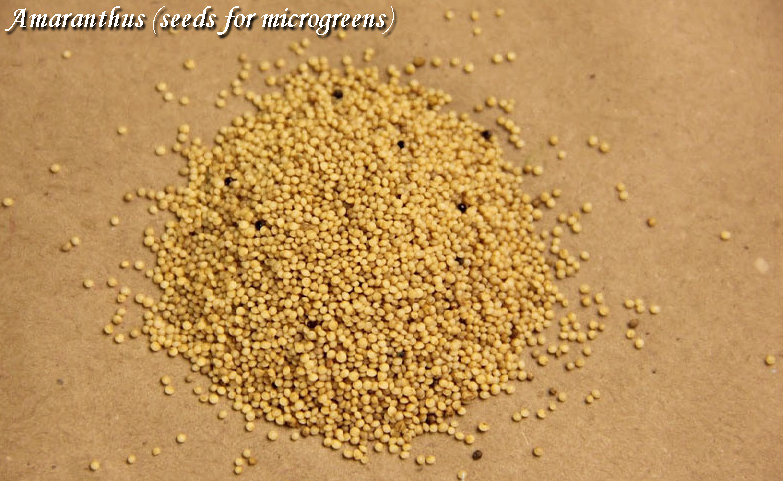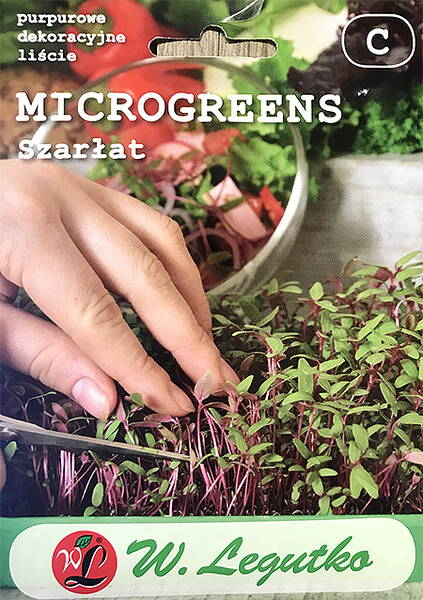A source of plant-based, easily digestible protein - a useful superfood for people who want to live vigorous and healthy.
Amaranth is famous for its tonic and anti-aging properties, as it contains squalene (the strongest natural antioxidant).
Its seeds, germinated on microgreens, are especially useful, because they have an increased concentration of nutrients.
Amaranth microgreens are consumed fresh: it has a mild taste, a neutral aroma and is in perfect harmony with both sweet and salty dishes (it is also popular for decorating a variety of dishes, including salads, side dishes, soups, sandwiches, smoothies, cold snacks and desserts).
Young sprouts of amaranth have anticarcinogenic, restorative, anti-inflammatory, they have a beneficial effect for the treatment and prevention of genitourinary, cardiovascular and oncological diseases.
Young seedlings of amaranth will be useful for diabetes, nervous disorders, obesity, atherosclerosis, insomnia, disorders of fat metabolism and Alzheimer's disease. In addition, they contribute to the healing of ulcers, erosions of the gastrointestinal tract (but not during an exacerbation!) and a decrease in blood cholesterol levels.
In addition, sprouted amaranth seeds can be called a "doctor" of the reproductive, immune and respiratory systems of the body, and for middle-aged and elderly men, it helps to get rid of impotence and restore sexual activity.
Nutritional value of amaranth sprouts:
- vitamins D, E, K, P, B1, B2, B5, B6
- calcium, potassium, phosphorus, copper, iron, magnesium in the chelated state of the substance
- pectins, phospholipids, phytosterols, fiber and squalene.
Ready: 5-10 days
Store microgreens in the refrigerator for up to 5 days.
Amaranth seeds remain viable for up to 5 years.

* It is not at all difficult to invent salads with amaranth yourself, since it goes well with any salad vegetables. You can even say that "you can't spoil a salad with amaranth."
With the traditional spring vitamin deficiency, any food and drink with this extraordinary greens will help to quickly eliminate vitamin deficiency. Here are some recipes for amaranth dishes:
SALAD: 200 g of amaranth leaves and 200 g of nettle leaves, 50 g of wild garlic leaves (can be replaced with leaves of young winter garlic) pour over boiling water, chop, salt, season with vegetable oil or sour cream.
Shchi: in 500 ml of meat or chicken broth with boiled potatoes add 400 grams of amaranth leaves and 100 g of sorrel leaves (before that, put the leaves in boiling water for 3 minutes). Cook for 10 minutes, remove from heat, break 2 raw eggs, beat lightly and pour into broth, stirring continuously (when serving, add sour cream to taste).
SAUCE: in a deep bowl, bring 300 g of cream to a boil, put 200 g of finely chopped young amaranth leaves in the cream; add 100 g of grated soft cheese and 5 g of black pepper into the hot mixture, put it back on low heat, stir until the cheese is completely melted.
CUTLETS: fry 50 g of amaranth seeds, make mashed potatoes (100 g) and peas (100 g), finely grate carrots (50 g); mix all products thoroughly with the addition of 2 raw eggs; make small cutlets, roll them in breadcrumbs or flour, fry in vegetable oil.
GREEN CUTLETS: prepare minced meat from 200 g of blanched amaranth leaves (dip in boiling salted water for 3 minutes, chop), 50 g of grated non-spicy cheese with a clove of garlic and 50 g of white bread pulp, 2 tablespoons of wheat flour; add 2 raw eggs, black pepper and salt to the minced meat; if necessary, dilute with a little cream; Roll the cutlets in breadcrumbs, fry in olive oil.
BITCHES: prepare minced meat from 200 g of fried seeds or amaranth flour, 150 g of meat passed through a meat grinder (beef, poultry), 2 eggs, salt to taste; roll the formed meatballs in wheat flour, lightly fry over high heat. Simmer in tomato sauce with sauteed onions and carrots.
TEA: a tablespoon of fresh or dried leaves and amaranth flowers (can be replaced with seeds) and half a teaspoon of lemon balm or mint, brew 100 g of water heated to 70 degrees; hold in a sealed container for 5-7 minutes, add boiling water to 200 g; sugar or honey to taste.
DRINK "VIBRITY": rub 4-5 large ripe tomatoes through a sieve (remove the skin from them first). Pour a glass of sour bread kvass or fermented milk drink Tan (Ayran, Kumis) into the resulting puree, add 7-8 crushed amaranth leaves, a quarter of a dessert spoon of ground black pepper. Beat the mass until smooth. The drink is ready to drink. Highly recommended for the male population as a folk "green viagra".
Amaranth has antitumor properties, which is why it is called the miracle plant of the XXI century.
The history of amaranth is interesting and tragic. His image was a symbol of immortality, and at home - in America, where for eight centuries before its conquest by Europeans, the Indians called him "the golden grain of God", "wheat of the Aztecs", "bread of the Incas", since it was the basis of their vegetable diet after corn, and in terms of the totality of its nutritional and medicinal properties, it was deservedly exalted much higher than any other food plant. However, some sacred Indian rituals using figurines of people made from amaranth flour, honey and human sacrificial blood, caused the ban on the cultivation of the "mystical grain of the Aztecs". This ban came from the Spanish conquistadors and was supported by the Catholic Church.
"The plant of the devil", as the Spaniards called it, for several centuries was banned on pain of death in Europe and forgotten in America itself.
Woutley (another of its names) was destroyed everywhere and only the Indians who lived in the remote mountainous regions of Central America saved it and continued to grow it.
This most valuable product experienced a rebirth in the 20th century, when serious research began on it in the United States. Now hundreds of research institutes around the world are engaged in the revival of this ancient culture.
There are more than 900 species of this plant, which are divided into vegetable, grain, fodder and decorative forms, although there are no clear boundaries between them (many types of amaranth have the properties of two or even all four forms at once, so they are universal in use).
Vegetable amaranths mainly include several varieties of tricolor amaranth (Amaranthus tricolor L.).
* The nutritional properties of amaranth can hardly be overestimated.
For comparison: the indicator of the nutritional value of amaranth protein is 75 units, and only 72 units of milk. Roots, stems, leaves, flowers and seeds, to one degree or another, are a source of oil, starch, vitamins, pectin, carotene, protein, trace elements, mineral salts, and sugar. This is a whole storehouse of unique protein of the highest quality, containing lysine - the most valuable and irreplaceable amino acid for the human body, which is 6-9% in protein, which is much more than in the protein of corn, wheat, rice (in Japan, the nutritional value of amaranth greens is compared to squid meat).
Flour and cereals from amaranth seeds are used as the most valuable food (up to 20%) additives in the production of dietary food: cereals, bakery, pasta, confectionery and baby food. When added to wheat flour (10%), baked bread and pastries acquire healing properties and do not stale for a long time.
At the moment, more than thirty types of food "amaranth-containing" products are produced in different countries of the world: noodles, pasta, sauces, chips, biscuits, muffins, waffles, cookies, soft drinks and beer. And this, in essence, is only the beginning of the great march across the planet of the "golden grain of God", called, according to N.I. Vavilov, to feed humanity.
There is no doubt about one thing - amaranth must be included in our daily diet!
Young amaranth leaves taste similar to spinach. They are consumed fresh, dried and canned. They are used in salads, soups, meat and fish dishes, in the preparation of sauces, casseroles, as fillings for pies, teas are brewed and added to compotes, a healing juice is obtained and syrups are prepared from it. Prepare amaranth greens for future use by drying and freezing.
Seeds, first of all, are a source of oil, miraculous in its properties, more valuable than sea buckthorn.
It is important to know that amaranth vegetable and grain varieties should have light seeds. If you find dark seeds, it means that amaranth is decorative. This type of width is not recommended for eating.
Amaranth is a cross-pollinated plant. Both cultivated varieties and varietal varieties with wild and varietal species can be crossed with each other. (It is for this reason that amaranth should be grown from seeds purchased in a specialized store).












